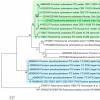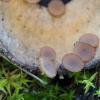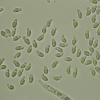
26-12-2025 21:19
Arnold BüschlenPithyella chalaudii Priou. Ist als Bryoparasit in

21-12-2025 09:32
Hello.A tiny ascomycete found embedded in wood in

18-12-2025 21:17
Pol DebaenstThe identification took me to Byssonectria deformi

24-12-2025 17:08
Hulda Caroline HolteHello, I have found this propoloid ascomycete on

21-12-2025 21:32
Pol DebaenstHello, Garden, Burgweg 19, Veurne, BelgiumOn 10/1
• Micro seems good for Rutstroemia too.
• Quercus petioles, macro, and spores suggest R. sydowiana.
Habitat: Stromatised petiole of Quercus robur, well-decayed leaf (but luckily the apex was intact), at the top of damp leaf litter, next to a pond, mixed deciduous woodland, Low Weald, England, early September, after lots of rain.
Apothecia: Appears to have been two, light brownish to blackish with yellowish disc, superficial, diameter ~3 mm and height similar, tooth-like groups of marginal hairs with exudate, concolourous with disc, disc appears shallow and plano-concave in maturity, with gelatinous appearance, receptacle with uneven and felty texture, darker network of hyphae visible, stipitate, blackened in lower-part, stromatised petiole with blackened mummified appearance.
Associates: Further up the petiole/mid-rib, several tiny, whitish, stipitate apothecia, size and colouring suggests a different species.
Asci: ~120-130 x 10-12 um, cylindrical-clavate, 8-spored, biseriate when turgid, croziers, apical ring strongly bb, seems like typical Rutstroemia form, apex rounded-truncate, more truncate when flaccid, apical thickening noticeable when immature or flaccid.
Spores: Reniform, apex hemispherical, base +/- acute, noticeably to strongly curved in profile view, inside the asci apparently filled with many tiny VBs but most coalescing in free spores to form ~3 large to medium VBs, apparently aseptate and uninuclear.
Measurements in water or IKI: (12.5) 13-15 × 5-6 µm, Q = (2.2) 2.5 - 2.76 (2.8), n = 10, mean = 14.1 × 5.4 µm, Q mean = 2.6.
Paraphyses: Long, cylindrical, irregularly inflated toward apex (~2.5-5 um), occasionally branched or bent at apex, multi-septate, apical cells filled with large yellowish VBs, possibly taller than the asci, some noticeable amyloid contents.
Marginal cells/hairs: Multiseptate, ~2-4 cells protruding, irregularly cylindrical, apparently gelatinised, with orangish brown exudate, around margin and on flanks, associated with the darker hyphae on the surface of the excipulum.
Medullary: Textura intricata (typica), appears to be separated from ectal ex. by several rows of horizontal hyphae, looks darker towards subhymenium.
Ectal ex: Hyaline, narrow hyphae on the surface, textura porrecta, patches of exudate, underneath large cells, textura prismatica, cells size seems to distinguish from horizontal hyphae.

I had a suspicion that the spore shape and substrate would be distinguishing, and then I found this species in your Rutstroemia folder. I also saw R. quercina reported on petioles of similar trees but there is only the sketch and the spores look different.

From the photos, the spores of R. petiolarum look distinctly more allantoid with a different pattern of VBs (and often with a lump protruding from each pole).

The sizes of the LBs depend on the spore shape, but it could still be helpful for visual confirmation.
The discussion around the protologue for R. petiolorum in Desm. says sometimes Quercus and Castanea, but at least one of the type collections looks like Fagus leaves (Desmazières, Pl. Crypt., Ed. 2, no. 658).
B&K 155 for R. petiolorum gives Fraxinus and Quercus and then adds Fagus. The main specimen is reported on Quercus but I find the drawing of spores hard to interpret and there are no LBs. I noticed R. longipes on Fraxinus petioles but this seems quite different.



Si, es cierto que R. sydowiana es una especie claramente confinada a los peciolos de las hojas de roble, pero en ocasiones también pueden crecer en las cupulas donde crece el fruto, en mi caso de Quercus faginea (Adjunto fotos), es solo una apreciación.
Saludos a todos
Curro Valencia

Esta coleccion fue recolectada el 12-12-2017
Saludos
Curro Valencia




 100x-Hym-0001.jpeg
100x-Hym-0001.jpeg


